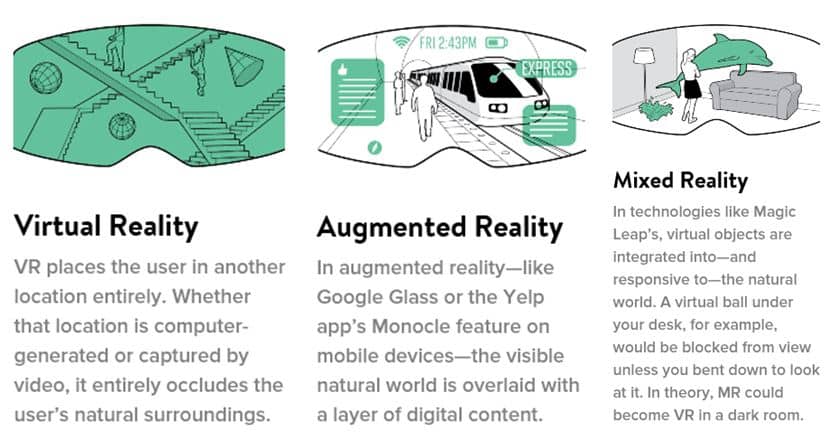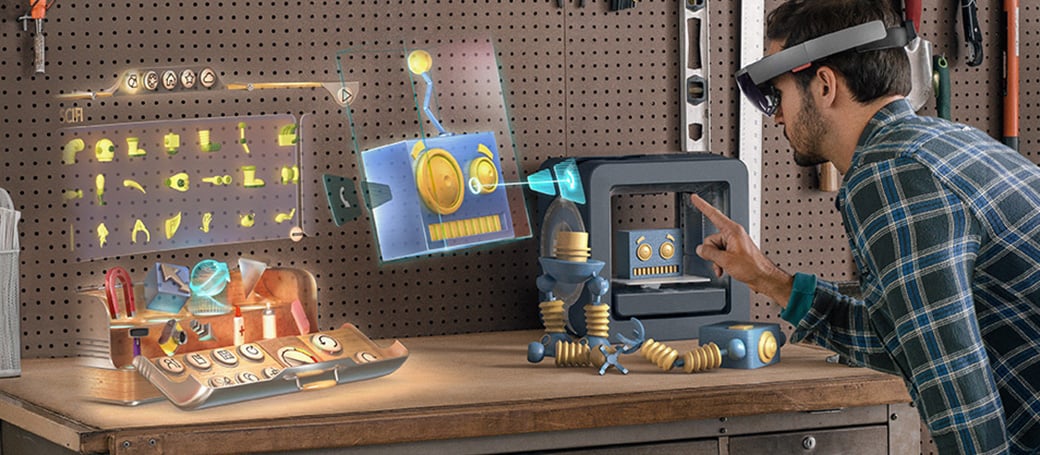
source: blog.intrepid.io
Last week I attended a community meeting for the Creating Reality AR/VR Hackathon being sponsored in part by USC, taking place in November, for anyone interested in participating in or helping to organize the event. As I listened to each speaker detail categories the event may consist of in the areas of virtual reality (VR), augmented reality (AR) and merged or mixed reality (MR), it occurred to me that I could only vaguely differentiate between these technolgies. After some much needed research on the subjects, this piece aims to serve as a review of the key differences in VR, AR and MR to better understand the various realities being presented.
Virtual reality (VR), the most well known of the three categories, is essentially immersion into a digital environment altogether with no interaction with the physical world (Wojciechowski & Cellary, 2013). In Virtual Reality Top Five Insights for Communicating Professionals, on whether or not VR is going through another fad phase since it’s inception in the 1980’s, James Berg, Senior Digital Planner and Insight Executive at PR agency Ketchum stated “the novelty of it will pass. And that’s a good thing. Currently brands can connect with consumers using VR as a novelty.”
Once the novelty has worn off, he continues, “another, perhaps more plausible example of a business application would be a broker enabling a real estate buyer to walk-through a virtual London town house or New York City penthouse from anywhere in the world. Or how about a clothing retailer that allows users to browse the racks and, by tapping the headset, add items to their cart.” I experienced a virtual reality home tour at Posible LA’s Entrepreneur Summit through Century 21’s virtual tour of homes all over the United States.
Augmented reality (AR), often used in confusion with virtual reality, builds on the same concept of using digital content as virtual reality, but this content is then overlaid onto a physical environment such as a kitchen, grocery store or a game overlaid on a map. In augmented reality, a real-time interplay between physical environments and digital information occurs (Wojciechowski et. al, 2012). The key difference between augmented and virtual reality is that AR overlays digital information in a real environment (Liberati, 2016), unlike virtual reality which requires complete immersion of the senses with digital content (Bower, et. al, 2013).
Merged or mixed reality (MR) is seen by some as just another incarnation of augmented reality, however where augmented reality consists of any information overlaid onto a physical surface, merged or mixed reality offers integration between the two by allowing interaction with the digital content. According to Wired Magazine’s AR, VR, MR: Making Sense of Magic Leap and the Future of Reality, Peter Rubin states “in augmented reality, there are virtual objects overlaid on top of real objects, but they’re just little suspended movies—you can’t interact. Once you can interact with those not-really-there objects, that’s the realm of mixed reality.” Online education company Pluralsight notes this shift means that “users use natural interactions to manipulate the digital world and they can be in any room, using any surface,” through technology such as Microsoft’s Hololens.

Source: Nanylyze.com
Interplay between and immersion in digital environments can create innovative experiences through meaningful interactions versus reading about or watching someone else’s experience (Kesim & Ozarslan, 2012; Liberati, 2016). Such applications have been tested in various industries such as medicine, robotics and entertainment since the 1990’s and has more recently been tested in education to explore learning through augmented reality applications and their effects on engaging students (Bower, et. al, 2013).
The various realities offer ways to connect with digital content, each with its own unique way to relay the user experience. Some applications use interactive objects which contain programmed information while others require users to complete tasks in various environments (Carmigniani, et. al, 2011). Virtual reality replaces the real world with a virtual world and augmented reality overlays content onto the real world. Mixed reality can transport users to a virtual world with overlaid content, but also allows for interaction with this content, such as manipulating holograms. The combination of these factors and many others prove the multifaceted digital reality experiences are here to stay.
Here are some examples of current applications of the technologies:
Virtual Reality
Björk Digital: Sonic dreams become virtual reality in downtown L.A.
“The exhibit has three distinct components. The first features six virtual reality experiences made for her most recent album, “Vulnicura,” which transport viewers in custom headsets to far-flung and unexpected places including a windswept beach in Iceland and the interior of the singer’s mouth.”
– L.A. Times
Google AR and VR efforts in the retail sector with virtual shopping tech
“Daydream, Google’s VR platform, will allow users to try out clothes and furniture virtually. On Wednesday, the company announced that Daydream will incorporate Google’s augmented reality platform Tango. The company showed examples of a partnership with San Francisco-based clothing company Gap Inc. for an AR app that lets users visualize themselves in outfits.”
– Biz Journals
Augmented Reality
Lowe’s unveils AR app for in-home projects
“Lowe’s has been aggressively developing new technologies, in fact, just a few months ago Lowe’s announced a Vision app leveraging Tango, but that app was targeted more at in-store navigation and needs.This app is targeted for use outside of the physical Lowe’s store. It’s about as close as you can get to buying the thing, having it delivered, installing it and seen it in the space — except the app takes all the nervousness, risk and mystery out of the equation.”
– Retail Dive

source: redbull.com/en/games/stories/1331804885230/pokemon-go-tips-red-bull-games
Creator of Pokemon Go on Augmented Reality
John Hanke says “in a VR situation, you’re isolating yourself from everyone around you and entering this completely virtual space. AR is designed to add, enhance the things you do as a human being: Being outside, socializing with other people, shopping, playing, having fun. AR can make all those things better.”
– Recode
Merged or Mixed Reality
Magic Leap Augmented Reality Whale Hologram Demo
“When you’re wearing the visor of an augmented- or mixed-reality system such as Magic Leap, HoloLens, or Meta, it maps the local environment. To make, say, a virtual teacup appear on your real table, it needs to know where your table is. The visor uses outward-facing cameras and sensors to scan your environment to create this map. Magic Leap (among others) is working on protocols that save a mapped place in the cloud so it doesn’t have to be remapped for each encounter.”
– Wired.

source: microsoft.com/en-us/hololens/why-hololens
Why Hololens?
“Transform the ways you communicate, create, collaborate, and explore. Your ideas are closer to becoming real when you can create and work with holograms in relation to the world around you. See holograms from your colleague’s perspective even if she’s on the other side of the world. Explore ideas in the real world, inside and out.”
– Microsoft
USC
USC students produce 360 Virtual Reality Tour of Wallis Annenberg Hall in one-of-a-kind VR journalism class
USC Annenberg professor Robert Hernandez, taught a virtual reality course in Fall 2015 where his students produced a 360 virtual reality tour of Wallis Annenberg Hall featuring Dean Ernest Wilson “The video was shown at the Online News Association conference in September using Google Cardboard.”
References
Bower, M., Howe, C., McCredie, N., Robinson, A., & Grover, D. (2013). Augmented reality in education – Cases, places, and potentials. In Proceedings of the 2013 IEEE 63rd Annual Conference International Council for Education Media, ICEM 2013. IEEE Computer Society.
Cadavieco, J. F., Goulão, M. D. F., & Costales, A. F. (2012). Using augmented reality and m-learning to optimize student’s performance in higher education. Procedia – Social and Behavioral Sciences, 46, 2970–2977.
Carmigniani, J., Furht, B., Anisetti, M., Ceravolo, P., Damiani, E., & Ivkovic, M. (2011). Augmented reality technologies, systems and applications. Multimedia Tools and Applications, 51(1), 341–377.
Cuendet, S., Bonnard, Q., Do-Lenh, S., & Dillenbourg, P. (2013). Designing augmented reality for the classroom. Computers and Education, 68, 557–569.
Duh, H. B. L., & Klopfer, E. (2013). Augmented reality learning: New learning paradigm in co-space. Computers & Education, 68, 534–535.
Kesim, M., & Ozarslan, Y. (2012). Augmented reality in education: Current technologies and the potential for education. Procedia – Social and Behavioral Sciences, 47(222), 297–302.
Klint, Lars. “Holographic Programming: A HoloLens How-to in a Mixed Reality World.”Pluralsight. Pluralsight, 27 May 2016. Web. 28 May 2017.
Liberati, N. (2016). Augmented reality and ubiquitous computing: The hidden potentialities of augmented reality. AI and Society, 31(1), 17–28.
Santos, M. E. C., Chen, A., Taketomi, T., Yamamoto, G., Miyazaki, J., & Kato, H. (2014). Augmented reality learning experiences: Survey of prototype design and evaluation. IEEE Transactions on Learning Technologies, 7(1), 38–56.
Wojciechowski, R., & Cellary, W. (2013). Evaluation of learners’ attitude toward learning in ARIES augmented reality environments. Computers and Education, 68, 570–585.
*Other referenced articles are hyperlinked.

2 Responses to Creating Digital Realities: The Difference Between VR, AR & MR